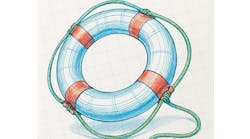This Control Talk column appeared in the April 2020 print edition of Control. To read more Control Talk columns click here or read the Control Talk blog here.
Greg: Both Hunter Vegas, co-founder of the ISA Mentor Program, and I wholeheartedly agree that we learn the most by mistakes made. The mistakes don’t necessarily need to be your mistakes, but you need to be involved enough to realize the problem, understand the consequences of the error and learn how to fix them.
Hunter, what were some of the biggest mistakes you have seen?
Hunter: One of my favorite lines is, “Pain is instructive,” and I can certainly list a host of mistakes made by myself and others over my 34 years of engineering. One particularly painful learning moment came early in my career when I encountered skid packages for the first time.
We were doing a large retrofit/conversion of an acid plant from an old sulfur burner to a spent acid regeneration plant and the project involved a large number of skid packages. (Packaged blowers/compressors, start up heaters, furnace controls, etc.) It was one of the first big projects I had ever managed and, at the time, I had had limited dealings with skid packaged equipment.
As a relatively green project manager, I naturally assumed the vendors would be “good at doing what they do” and would sell us a quality, well designed package. Wrong answer! What I ultimately got was a pile of very poorly documented, poorly designed units littered with bargain basement instrumentation that broke right after the check cleared. Ultimately we had to replace nearly all of the instruments and gut the controls packages on nearly every skid unit over the next few years. It was a learning experience that changed me forever. After that I had several hard and fast rules concerning skid packaged equipment. They included:
- Specify acceptable instruments down to the model number.
- Specify the control equipment (PLC, single loop controllers, DCS interface) in exquisite detail. If a DCS is available, ditch the local control and run the signals into the control system to provide visibility, alarming, historical trending and coordinated control with the rest of the plant.
- Specify what drawings are to be provided and in what format (i.e., AutoCAD version x)
- Demand the right to review all electrical/control drawings prior to fabrication.
- Specify any requirements for programming (rung comments, etc.) and specify that all programs are to be provided in advance for review. Also, the final programs must be provided in native format and not locked down/encrypted in any way. (In other words, be sure you own the logic and can edit it if necessary.)
- Avoid relying solely on communication links for data transfer. Hardwire critical IO signals. Every skid manufacturer will assure you their communications is “plug and play” and they are nearly always wrong. It will often take days of effort to get the first bit across. It also requires hours of effort to drag the communication parameters, data maps, etc., out of the vendor. If you are given anything, it is usually wrong and you will have to make it work when the equipment arrives on site. If a communication link is involved, demand that it be tested/proven during the field acceptance test (FAT). (See next item.)
- This was a big one—insist on a full functioning factory acceptance test AT THEIR SITE prior to shipping. If it doesn’t work or they have issues/errors, they fix them at that time and retest before it ships. Do not allow them to ship the equipment with a promise to fix it on site. (Because invariably the fix will not happen!)
- Finally, a big chunk of the final payment should be held back pending delivery of all the required documents, programs, etc., as well as proof of operation.
Long story short, take the time to create a very tight specification as it will save you untold money, misery and downtime in the future.
After that painful start up, I would present my specifications as part of the bid and invariably the skid manufacturers would balk, saying the package would cost more as I was deviating from their “standard offering.” I didn’t care—the little extra money I paid to get the skid engineered and constructed correctly was nothing compared to the cost of unplanned downtime and equipment replacement I would suffer otherwise.
Greg: I have seen pressure and temperature gauges and field switches used instead of transmitters, insufficient straight runs for D/P flow measurements, pitot tubes, local controllers, laboratory instead of industrial control valves, and poor sensor locations. These problems stem from the emphasis on cost, space and portability rather than system performance. The people making decisions on the bid packages often don’t understand automation or the implications of poor instrumentation design and installation. The resulting problems can occur not only in skids but anywhere in the plant. The cost of fixing the problem after the fact is much more in terms installation and loss in process performance. I personally wonder if skid manufacturers and suppliers of automation systems have the people with the field experience and understanding of the importance of automation system capability, maintainability and accessibility.
If a flow, level, pressure or temperature requires action or is important for diagnostics or process understanding, it should be accurately measured and transmitted to the control room. This is not widely understood or appreciated. When I was doing a Mentor post on how to improve temperature measurement, the figure chosen by the software guy doing the post showed temperature gauges, to my dismay. Flow, level, pressure and temperature switches should be digitally set in the system configuration using hardwired signals from the best transmitters. This leads to better accuracy, visibility and reliability.
I am extremely uncomfortable not knowing the condition, error, and impending actuation or fault in a field switch. I was dismayed sitting in a talk, where the use of level switches instead of level transmitters was unconditionally advocated. A young engineer working at the supplier’s home office stated that you should trust his recommendations since he had a college degree. I wondered what university teaches what is truly needed in instrumentation. Even if such a rarity existed, to discount the experience of practitioners working industry on day to day applications is disconcerting.
The problem with local controllers extends beyond skids and is more insidious in that vendors have touted the special capabilities of their field controllers. Most notably fuzzy logic controllers (FLC) have been promoted to provide a temperature controller that minimizes overshoot of setpoint changes. I have tested FLC and found that they are not robust, can be difficult to tune, and in particular don’t have the disturbance rejection capability achieved by a PID with a good amount of proportional and derivative action. Setpoint overshoot can be simply minimized in a PID by a setpoint filter or structure.
The real killer is that the special controller is a “special,” posing maintenance and operational problems, tuning difficulties and process control improvement limitations. The fact that the controller is not in the main control system prevents coordination including procedure automation for startup and feedforward control and restricts operator and process visibility and understanding of what the controller is doing. The loss of the control room faceplate and trend chart for the controller mode, input, output and setpoint introduces process safety as well as troubleshooting and performance concerns.
Laboratory control valves may work okay in the protected environment of a research lab but when put out in an industrial plant, the thin stems are easily bent resulting in severe stiction. Often these valves don’t have positioners, which may seem okay in a lab since operating conditions are so well regulated that the valves don’t have to compensate for disturbances.
Then there is the persistent, widespread problem of on-off valves posing as throttling valves. These valves are cheaper and have a tighter shutoff and more capacity. Valve specifications do not require the valve meet precision, (e.g., deadband and resolution) and response time requirements. The best protection against posers is to specify the manufacturer and model number of valve body, shaft connections, actuator, positioner that must be used. Also, require the actuator be able to handle more than 150% of thrust requirement. Marginally sized actuators are often stocked in an attempt to lower cost making them look more attractive for bids. See the Control article “How to specify valves and positioners that do not compromise control.”
10. I dare you to find anything else cheaper
9. Trust me, I have a college degree
8. No signal wiring is required
7. It is totally standalone
6. You can move it anywhere
5. It has the fuzziest of fuzzy logic controllers
4. No controller tuning is needed
3. We don’t need your process or environmental operating conditions
2. We got the exact skid you need in stock
1. We have been working closely with your purchasing agent to get the right skid







